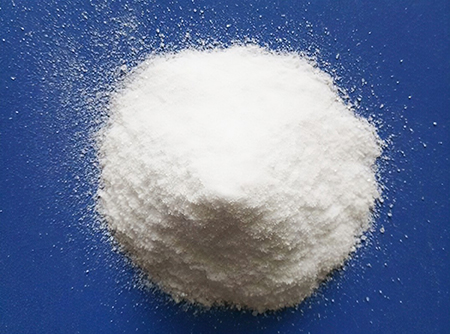The synthetic methods of sodium hexametaphosphate
Introduction
Sodium hexametaphosphate is an inorganic substance with the molecular formula (NaPO3)6, white powder crystal, or colorless transparent glass flake or block solid[1]. Soluble in water, insoluble in organic solvents. It has strong hygroscopicity, and when exposed to the air, it can gradually absorb water and become a sticky substance. It can form soluble complexes with metal ions such as calcium and magnesium. It has a wide range of uses in both food and industrial fields.

Picture 1 Physical map of sodium hexametaphosphate
The synthetic methods of sodium hexametaphosphate
1. Sodium dihydrogen phosphate method: neutralize the soda ash solution with phosphoric acid at 80-100 ℃ for 2 hours, the resulting sodium dihydrogen phosphate solution is evaporated, concentrated, cooled and crystallized to obtain sodium dihydrogen phosphate dihydrate, heated to 110 ~230℃ to remove 2 crystal waters, continue to heat to remove structural water, further heat to 620℃ to dehydrate, and the resulting sodium metaphosphate melt is polymerized into sodium hexametaphosphate. Then unloaded, quenched from 650°C to 60-80°C, tableted, and pulverized to obtain the finished product of sodium hexametaphosphate.
2. Phosphorus pentoxide method[2]: The phosphorus pentoxide obtained by burning, oxidizing and cooling yellow phosphorus in a dry air stream is mixed with soda ash in a certain proportion (Na2O: P2O5=1~1.1). The mixed powder is indirectly heated in a graphite crucible to dehydrate and fuse, and the resulting sodium hexametaphosphate melt is quenched, tableted and pulverized to obtain an industrial sodium hexametaphosphate product.
3. Heat the reagent sodium dihydrogen phosphate to 700~900℃ to melt. When the melt is completely transparent and the internal bubbles disappear, it is quenched to 60~80℃ to obtain a flake glass product, which is sodium hexametaphosphate.
4. Heating the reagent sodium dihydrogen phosphate to 250°C and quenching to obtain the dimer of sodium metaphosphate; heating to 650°C and quenching to obtain sodium hexametaphosphate.
5. Phosphoric anhydride method: After heating and melting the yellow phosphorus, it is sent to an oxidative combustion furnace, and the oxidative combustion reaction is carried out with oxygen in the dry air to generate an intermediate product, phosphoric anhydride. After mixing phosphoric anhydride and soda ash, high temperature polymerization reaction, quenching tablet to obtain flake sodium hexametaphosphate; after crushing, powdery sodium hexametaphosphate can be obtained.
6. Neutralization polymerization method: respectively pass phosphoric acid and liquid sodium hydroxide through their respective batch controllers (control the input amount of liquid alkali and acid in each batch, can be automatically batched, and the feeding speed can be adjusted arbitrarily within the range of 0~20L/min) , according to the required dosage, continuously and accurately add it to the neutralization tank for neutralization reaction. After the reaction is completed, the pH value reaches 4 to 4.4, and disodium hydrogen phosphate is generated, which is pumped into the high-level tank through the neutralization liquid pump. A certain amount of disodium hydrogen phosphate is continuously and evenly sent to the dryer for drying to obtain flake disodium hydrogen phosphate with a specified moisture content, and then continuously sent to the high temperature (750 ℃) of diesel combustion made of special corrosion-resistant materials. ~850℃) in a polymerization furnace, melt and polymerize disodium hydrogen phosphate; the molten material flows out continuously from the polymerization furnace, and is quenched and pressed to obtain flake sodium hexametaphosphate, which is crushed and screened to obtain the product.
Application of sodium hexametaphosphate in food and industrial industries
Sodium hexametaphosphate is used in meat products, fish sausages, ham, etc. It can improve water holding capacity, increase adhesion and prevent fat oxidation. Sodium hexametaphosphate used in soybean paste and soy sauce can prevent discoloration, increase viscosity, shorten fermentation period and adjust taste. Sodium hexametaphosphate is used in fruit drinks and refreshing drinks, which can improve the juice yield, increase the viscosity, and inhibit the decomposition of vitamin C. The use of sodium hexametaphosphate in ice cream can improve the expansion capacity, increase the volume, enhance the emulsification to prevent the destruction of the paste, and improve the taste and color. Sodium hexametaphosphate is used in dairy products and beverages to prevent gel precipitation. Adding sodium hexametaphosphate to beer can clarify the liquor and prevent turbidity. Sodium hexametaphosphate is used in canned beans, fruits and vegetables to stabilize natural pigments and protect food color. Sodium hexametaphosphate Sodium hexametaphosphate aqueous solution sprayed on cured meat can improve antiseptic performance. Sodium hexametaphosphate can be heated with sodium fluoride to produce sodium monofluorophosphate, which is an important industrial raw material; sodium hexametaphosphate is used as a water softener, such as used in dyeing and finishing, to soften water. Sodium hexametaphosphate is also widely used as a scale inhibitor in water treatment industries such as EDI (resin electrodialysis), RO (reverse osmosis), and NF (nanofiltration).
Reference
1 Xia Qibin, Li Zhong, Qiu Xianyang, Dai Zilin. Study on the dispersion mechanism of sodium hexametaphosphate on serpentine. 2002
2 Feng Qiming, Zhou Qingbo, Zhang Guofan, etc. Inhibitory mechanism of sodium hexametaphosphate against calcite. 2011
Related articles And Qustion
See also
Lastest Price from sodium hexametaphosphate manufacturers

US $0.00-0.00/kg2025-12-02
- CAS:
- 10124-56-8
- Min. Order:
- 0.1kg
- Purity:
- 99%
- Supply Ability:
- 20ton

US $0.00/KG2025-09-15
- CAS:
- 10124-56-8
- Min. Order:
- 25KG
- Purity:
- 98%min
- Supply Ability:
- 30tons/month



